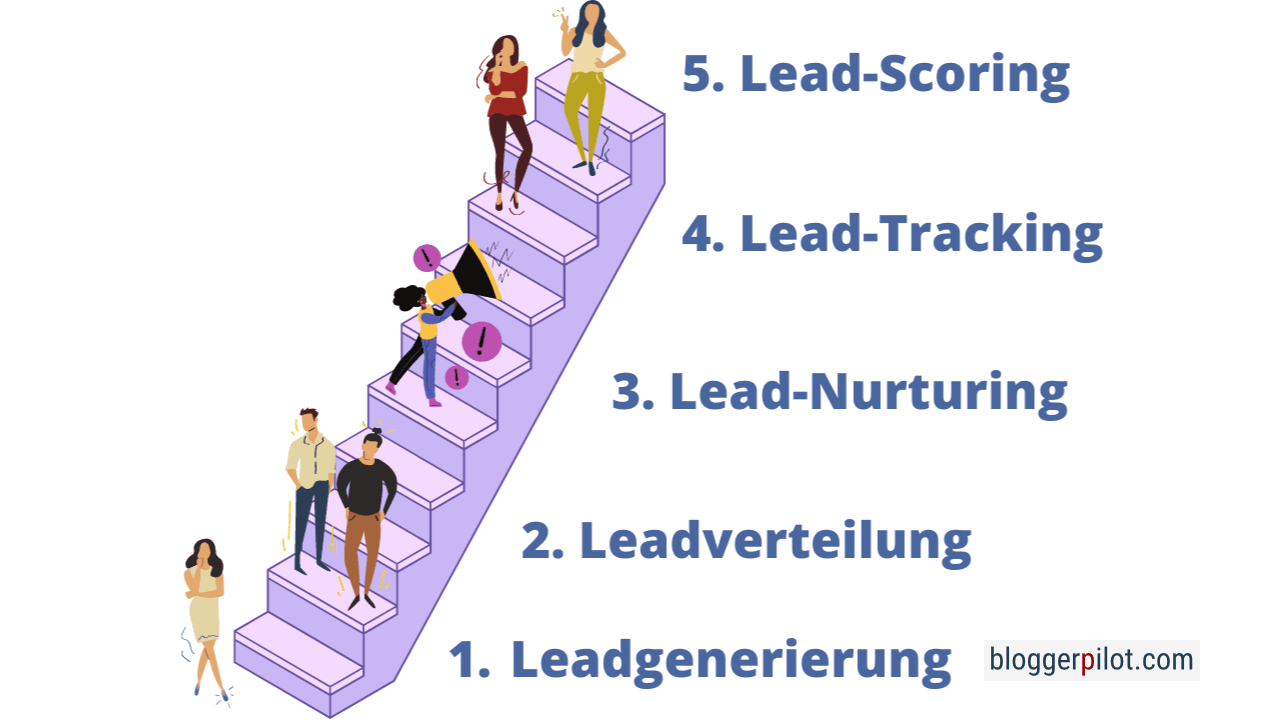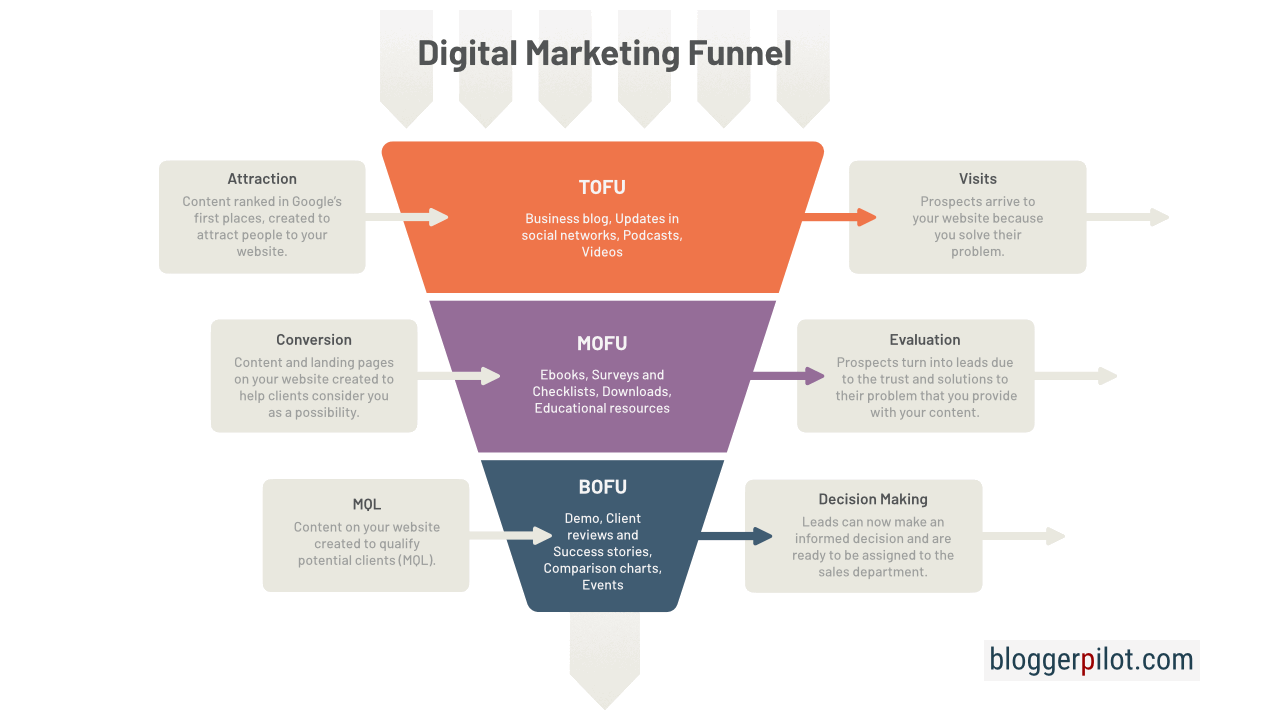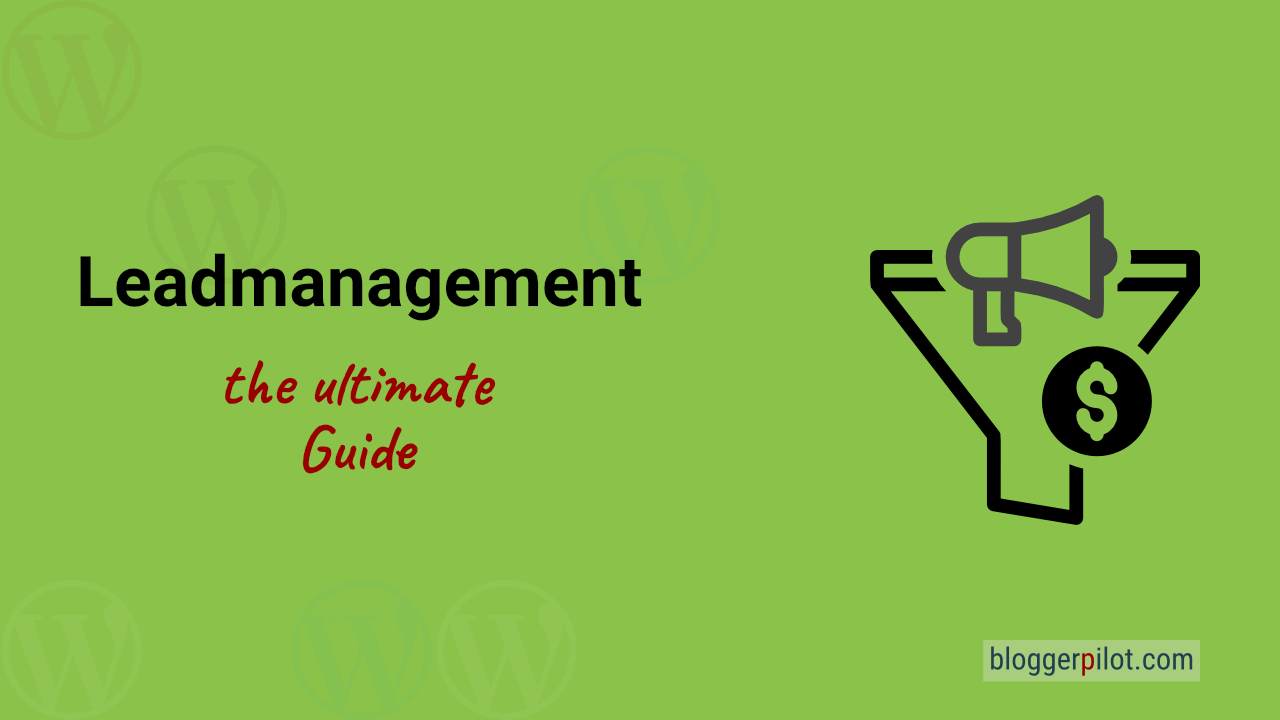Lead Management: Everything You Need to Know for Implementation
Lead management in online marketing. Imagine a world where prospects come to you. You know exactly what they want and how they came to you. Your only challenge is to be faster than the competition
Lead management is a process in sales and marketing. It includes all the actions and methods a company takes to convert prospects (leads) into customers. We are talking about online marketing here.
Modern technologies, such as lead management tools, bring you a bit closer to this idea. They are used to collect information about customer needs and develop a goal-oriented buying process. Lead management can dramatically improve new customer generation. If sales and marketing are new territory for you, there are still some interesting things to learn. This guide explains everything you need to know about lead management and how to get started successfully.
More About Lead Generation:
What is a lead?
Every company, regardless of industry or size, collects leads. By a lead, we mean a potential business contact who has already shown some form of interest in the offer. Depending on their status, leads are classified into categories such as qualified and unqualified leads. The ultimate guide to lead generation in online marketing tells you more about the classification into warm leads and cold leads and shows you how to follow up on them
What is lead management?

When you start a business, you begin with a handful of potential customers. But as the business evolves and grows, so does the need for new leads. It’s not that easy to convert these business leads into potential customers
In most cases, the biggest challenge is distinguishing between qualified and unqualified leads. Simply put, a prospect is considered qualified if they provide their contact information and agree to establish a dialogue. This could be signing up for your newsletter, for example. The goal of the dialogue is then to convert the prospect into a new customer. Online channels such as social media, email marketing, search engine marketing, Landing-Pages or providing free tools can help you drive lead generation and qualification. All of these actions and processes that guide you along the way are part of your lead management process.
To learn how a sales funnel works, check out my post on successful sales funnels
Why is lead management important?
Many prospects don’t buy right after the first or second contact. Especially with expensive products or, if it impacts their reputation, safety or health, the decision process can drag on
Lead management guides leads through a process with multiple touchpoints, allowing potential buyers to slowly build trust in you and your product. Plus, constant contact with customers keeps your product in their minds. When leads are finally ready to buy, it’s your company they turn to first. This way, you can build stable connections with your prospects and customers, improve the buying experience, and stay ahead of the competition. A well-organized lead management process can:
- improve the sales process and increase the chances of conversion.
- help you track/trace leads to better understand them.
- make the work of your sales team more effective.
A lead management process helps you keep your focus on what’s important and helps you target and adjust your marketing strategies as needed.
Effective lead management in 5 steps

1. Lead generation
“The lead generation process starts with finding out where your target market lives on the web.”
Wayne Davis
First, it’s important to find leads. Create engaging content and distribute it through relevant marketing channels. Depending on your target audience and your offering, this could be in the form of blog posts, white papers, photos, or infographics. Most target groups are active on social media and ask Google when they get stuck. You can use this knowledge and attract them to your website via social media or SEO measures. For the ins and outs of digital lead generation and much more, check out my ultimate guide to lead generation.
Lead generation example
Your marketing team has identified the buyer type and created a persona based on demographics, behavioral patterns, and using the optimal lead source. Now
- create interesting content and publish it to your target audience’s most popular channels.
- at the end of your helpful posts, you give leads the opportunity to sign up for a newsletter.
2. Lead distribution
Imagine your sales team receives successfully generated leads from marketing. Lead management ensures that these leads are assigned to the right sales person and that the information is available so that all team members are on the same page.
Lead distribution example
You develop a lead distribution process where:
- Leads whose location is California are routed to the US team.
- Leads who are interested in category A products are routed to your product group A specialist.
- Leads who have already purchased product B will be routed to your cross-selling professional, since you already know who buys product B will usually also benefit from product C.
3. Lead Nurturing
Let’s say you bite into a green banana. Do you like it? Probably not. But the fault lies not with the banana, but with you. You bite into it before it is ripe.
What does this have to do with lead nurturing, you ask? The fault, as we’ve established, is not with the banana, but with you. It’s the same with a lead that gets served the banana too early. To avoid the so-called “green banana effect”, leads must not be handed over to sales too early, as they need to be “ripe” and show interest in your product so that your offer fits the current need.
Lead nurturing is about nurturing the relationship with the potential customer and increasing trust in the brand. This process has multiple goals: to move the lead forward in the customer journey, to close new deals, and to get existing customers to attract new leads.
Lead Nurturing Example
You create an effective lead-nurturing campaign including:
- Content mapping to determine the style of posts for different lead types.
- personalized email and social media communications to build a relationship with the lead.
- diligent outreach. You’ll provide them with engaging content until they’re ready to be passed on to the sales team.
4. Lead tracking
A prospect’s email address and phone number aren’t necessarily enough to start a successful sales process.
You should also know about whether the customer is even interested in a sales conversation. You can find this out through lead tracking.
Example of lead tracking
Lead tracking is where you track the activity of your leads. To understand and assess your leads, you track:
- the website visits.
- the clicks on and opens of your emails.
- the responses to SMSes and WhatsApp messages.
5. Lead scoring
Lead scoring is a method for ranking leads. It uses qualifiers to determine a potential customer’s interest and willingness to buy. The purpose of lead scoring is to ensure that only leads that are close to making a purchase are referred to sales. The higher the score, the greater the likelihood that leads will become buyers.
Example of lead scoring
With lead scoring, you want to capture and score information:
- demographic information and behavior patterns.
- Company information such as revenue and number of employees.
- response to messages, event invitations, and freebies.
Generate leads using the sales funnel

The path your leads take is called a sales funnel, marketing funnel, or content funnel. It is considered a classic model for lead management in all industries and is divided into three sections. Here, the prospect is guided through the funnel by content that becomes more and more specific and, in the best case, matures into a customer over a certain period of time. The three phases in lead management look like this:
1. Top of the funnel
In this phase, the lead generation process begins. Here you can use general content to pique the interest of the leads.
2. Middle of the funnel
Now you are in the intermediate stage. Here the focus is on lead development. This means that your lead is provided with a lot of specific information.
3. End of the funnel
The content at the end of the funnel is precisely targeted to the individual customer’s needs, which means that potential customers only need to access it
Too theoretical? Get inspired by the best practices sales funnels.
What are inbound and outbound marketing?

Outbound marketing
Outbound marketing includes all the methods a company uses to acquire leads – in other words, advertising as we know it, especially from the past. This type of advertising is characterized by campaigns that promote companies and products without being asked and without reference. Leads are to be reached through proactive campaigns. Your company determines the timing and means of interacting with your target audience in outbound marketing.
Examples of outbound marketing:
- TV commercials
- Events
- Flyers
Inbound marketing
Inbound marketing, on the other hand, is a marketing method that tries to generate interest through relevant content so that prospects will contact your company on their own. More and more companies are turning to inbound marketing and SEO.
Examples of inbound marketing:
- Online seminars
- Podcasts
- Blogs
Outbound vs. inbound marketing – these are the pros and cons
One of the biggest strengths of inbound marketing: your prospects are provided with lots of value. No annoying ads, no “me me me” content. Instead, there are helpful tips and tricks, or entertaining and exciting content – right when your leads need it most
Because inbound marketing is oriented around the buyer’s journey, it helps you build a connection between your prospects and your brand. Potential customers are made aware of your brand and your offer at the right time. That’s why many buyers prefer inbound marketing. Customers don’t feel harassed, but are happy to receive relevant content.
The biggest advantage of outbound marketing: you can reach a large number of people quickly and increase your brand awareness. You can gain new customers in a very short time with an outbound marketing campaign. However, the results depend heavily on your investment. Usually, success ends as soon as money stops flowing into the campaigns.
You see, both have their raison d’être. A combination can lead to the best possible success. For example, you can use outbound marketing to navigate your inbound world and accelerate your inbound results.
How can you manage leads intelligently?
Lead management software can help intelligently segment cold and warm leads so sales reps can easily prioritize their tasks. They can focus on warm leads as a priority and tackle cold leads later, once the number of active leads decreases.
5 reasons to use lead management software
The more relevant and timely your sales team can target leads, the better. Without a system, you may not get the right information to best support your sales team.
1. Manage leads smartly with lead management software
Lead management software can help filter qualified and unqualified leads. Then, sales reps can focus on qualified leads.
2. Use lead management software to track the sales pipeline
Tracking leads in a sales pipeline is intuitive and provides an overall view of ongoing activity. A pipeline view allows the sales team to close deals more efficiently and also keep an eye on the conversion rate within the pipeline. This allows optimization potential to be quickly identified.
3. Centralize relevant data with lead management software
All information about your contacts is stored in one place and is easily accessible to everyone on the sales team. You no longer run the risk of missing important information that can cost you conversions.
4. Manage sales activities efficiently with lead management software
The software notifies you regularly about upcoming follow-ups, follow-up appointments, and other activities.
5. Increase sales rep productivity with lead management software
If you think you’ll have the same effect with an Excel list, you should experience it for yourself. Lead management software enables collaborative and intuitive work, which makes the work within the sales team much more effective. Not only does this save time and money, but most importantly, it is fun to work with the tools.
The most popular lead management software from OMR Reviews

- Salesforce CRM
Salesforce is the customer relationship management (CRM) system of choice for many businesses. The CRM software from combines a CRM database, customer relationship management, collaboration and analytics software to keep customer data and interactions in one place. - HubSpot Sales Hub
HubSpot Sales Hub is designed to manage all customer contact. The tool’s main purpose is to ensure that leads can be clearly sorted, segmented and targeted. For example, HubSpot shows where website visitors come from and automatically evaluates how they behave on a website. When a customer list of existing customers is researched, potential customers can be tracked down. - TecArt CRM
TecArt CRM is a web-based CRM software for medium-sized companies. It is flexible, individually scalable, automates communication and offers various modules for customer and project management, groupware and ERP. - SuperOffice CRM
The cloud-based CRM tool is designed to connect, digitize and automate all sales processes. For professional lead management, marketing features include lead page creation, a “newsletter configurator” with campaign tracking, and follow-up activities for sales and customer service. - Pipedrive
Pipedrive is probably known to many for its visualized “sales pipelines.” This allows users to see at a glance the current status of a deal with a customer. The project, launched in 2010, was developed by salespeople for salespeople. - CentralStationCRM
CentralStationCRM is aimed primarily at teams in small and medium-sized businesses. The tool focuses on ease of use and basic CRM functions: Task and contact management, communication history and collaboration. Above all, the fledgling company promises that everyone on the team will understand and use CentralStationCRM right away. - Microsoft Dynamics 365 Sales
Dynamics 365 Sales from Microsoft is a CRM tool that helps salespeople manage leads and contacts. The CRM tool is directly linked to Office 365. - weclapp
weclapp is a cloud ERP platform that automates all business processes for SMBs. Whether it’s CRM, project management, enterprise resource planning or accounting software, weclapp offers solutions for the whole team and is profitable. - Zoho CRM
Zoho’s CRM tool is used by 250,000 companies around the world. It offers the ability to bring all customer data and interactions together in one place. Automations are especially useful for new customer acquisition. For example, data can be synchronized from other applications and emails can be sent.
Conclusion on lead management
Lead management is essential for any growing business. It gives you a clear overview, allowing you to make the right decisions.
With lead management, you no longer have to leave your success to chance, but simply control it yourself. With acquired customer and sales information, facts determine all your processes and strategic measures. Your success becomes scalable, allowing you to make realistic forecasts and set clear goals that move you and your company forward.
